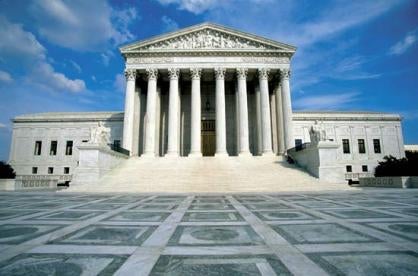In a carefully crafted 7-2 decision in B&B Hardware, Inc. v. Hargis Industries, Inc., the Supreme Court of the United States reversed the US Court of Appeals for the Eighth Circuit and granted preclusive effect to Trademark Trial and Appeal Board (TTAB) registration decisions, but only in limited circumstances.
Key Takeaways
-
The US Supreme Court granted preclusive effect to TTAB decisions, but only where (a) the other elements of issue preclusion are met, and (b) the TTAB considered the actual marketplace usage of the mark (instead of limiting its inquiry to the face of the registration/application at issue), and such actual marketplace usage is "materially the same" as the coverage of the registration/application.
-
The Court did not provide specific guidance on application of the "materially the same" usage standard, but it noted that "trivial variations between the usages set out in the application and the use of the mark in the marketplace" are not sufficient to avoid preclusion.
-
The Court acknowledged that many TTAB decisions will not have preclusive effect.
-
The Court did not resolve the issue of whether and how often the TTAB should consider usages beyond those listed in the application/registration.
-
The decision left the door open for various interpretations of, and much debate over, the "materially the same" usage standard.
Case Discussion
B&B Hardware addresses a circuit split regarding whether a TTAB registration decision on the likelihood-of-confusion between trademarks precludes a federal court from later ruling on the same issue in a trademark infringement case. For example, if Party A unsuccessfully opposed Party B's trademark application before the TTAB, can Party A nevertheless file a trademark infringement lawsuit in federal court against Party B regarding the same marks? The answer depended on the jurisdiction, and even then, different jurisdictions seemed to apply different levels of preclusion.
The Supreme Court made clear in B&B Hardware that TTAB decisions are entitled to preclusive effect, but only where (1) the other elements of issue preclusion are met, and (2) the TTAB considered the actual marketplace usage of the mark (instead of limiting its inquiry to the face of the registration/application at issue), and such actual marketplace usage is "materially the same" as the coverage of the registration/application.
The Court did not provide specific guidance on application of the "materially the same" usage standard, but it noted that "trivial variations between the usages set out in the application and the use of the mark in the marketplace" are not sufficient to avoid preclusion. The Court also acknowledged that many TTAB decisions will not have preclusive effect, for example, when the TTAB does not review the actual marketplace usage of the marks.
B&B and Hargis both sell metal fasteners under the mark SEALTIGHT. B&B's metal fasteners are sold in the aerospace industry, and its registration for the SEALTIGHT mark was expressly limited to that industry. Hargis's metal fasteners are sold in the construction industry, and its application for the SEALTIGHT mark was limited to "use in the manufacture of metal and post-frame buildings."
The parties' dispute over the SEALTIGHT mark lasted for nearly two decades before the TTAB and federal courts. B&B successfully opposed Hargis's application before the TTAB. Hargis did not appeal. In a simultaneous district court proceeding, B&B argued that the TTAB decision should be given preclusive effect. The district court disagreed and the jury returned a verdict for Hargis. B&B appealed to the Eight Circuit, which affirmed.
On appeal to the Supreme Court, the Court focused on three primary issues: (1) whether agency decisions can ever enjoy preclusive effect; (2) whether there was an "evident" reason why Congress would not want TTAB decisions to have preclusive effect; and (3) whether there is a categorical reason why registration decisions can never meet the ordinary elements of issue preclusion as set out in §27 of the Restatement (Second) of Judgments.
Regarding the first issue, the Court concluded that issue preclusion is not limited to situations in which the same issue is before two courts, but rather it may also apply as between a court and an administrative agency. The Court held that "when an administrative agency is acting in a judicial capacity and resolves the disputed issues of fact properly before it which the parties have had an adequate opportunity to litigate, the courts have not hesitated to apply res judicata to enforce repose." The Court noted that Hargis did not raise constitutional arguments regarding right to trial-by-jury under the Seventh Amendment, or separation of powers between Article III courts and Article II executive branch agencies, and thus such issues were not decided. The Court declined to read the Lanham Act narrowly to prohibit issue preclusion.
On the second issue, the Court held that nothing in the Lanham Act bars application of issue preclusion in cases where the ordinary elements of issue preclusion are met. That the Lanham Act provides for de novo review of TTAB decisions in federal court did not make it "evident" that Congress did not want issue preclusion to apply. The Court noted, however, that "for a great many registration decisions issue preclusion obviously will not apply . . . [f]or those registrations, nothing we say today is relevant."
Regarding the third issue, the Court found that the likelihood-of-confusion tests employed by the TTAB and federal courts are the "same," despite acknowledging that: (1) some of the individual likelihood-of-confusion factors are different; (2) the TTAB sometimes does not evaluate the actual usage of the mark in the marketplace; and (3) the TTAB and courts follow different procedures in their analyses. In particular, the Court pointed to similar language central to TTAB and court inquiries, namely, whether a junior mark is "likely" to "confuse" consumers, and to the fact that federal courts have the power to cancel registrations in infringement cases under the same test, not two different tests. Regarding the different procedures at the TTAB and courts, the Court noted that the correct inquiry is whether the procedures in TTAB proceedings are "fundamentally poor, cursory, or unfair"—which, the Court decided, was not the case.
Importantly, the Court held that where the TTAB does not evaluate the actual usage of the mark in the marketplace, issue preclusion does not apply. That, however, was not sufficient for the Court to categorically reject issue preclusion for the TTAB decisions that do satisfy the ordinary requirements. The Court stated:
If a mark owner uses its mark in ways that are materially the same as the usages included in its registration application, then the TTAB is deciding the same likelihood-of-confusion issue as a district court in infringement litigation. By contrast, if a mark owner uses its mark in ways that are materially unlike the usages in its application, then the TTAB is not deciding the same issue. Thus, if the TTAB does not consider the marketplace usage of the parties' marks, the TTAB's decision should 'have no later preclusive effect in a suit where actual usage in the marketplace is the paramount issue.' Materiality, of course, is essential—trivial variations between the usages set out in an application and the sue of a mark in the marketplace do not create different 'issues,' just as trivial variations do not create different 'marks.'
The Court acknowledged in a footnote—but did not resolve—the issue of whether and how often the TTAB should consider usages beyond those listed in the application or registration. That is critical because, as noted by the Court, the TTAB "typically analyzes the marks, goods, and channels of trade only as set forth in the application and in the opposer's registration, regardless of whether the actual usage of the marks by either party differs." Without clear guidance from the Court, TTAB litigants lack certainty as to whether the TTAB will adhere to that general principle, and as a result, whether issue preclusion will not apply in a subsequent court action.
Finally, the Court rejected the argument that the stakes for registration are so much lower than for infringement that issue preclusion should never apply to TTAB decisions. Instead, noting that the benefits of registration are "substantial" and that parties should take registration decisions seriously, the Court held that such decisions are "weighty enough to ground issue preclusion."
The Court remanded the case to the Eight Circuit to apply the "materially the same" usage test along with the traditional issue preclusion factors.
Justices Thomas and Scalia dissented, focusing primarily on the majority's presumption that administrative agency decisions have preclusive effect where agencies are authorized by Congress to resolve disputes in an adjudicatory setting. The dissent noted that the "presumption was first announced in poorly supported dictum in a 1991 decision of this Court, and we have not applied it since." It also raised "serious constitutional concerns" regarding separation of power between Article III courts and Article II executive branch agencies.
Conclusion
This decision carries much significance in trademark opposition and litigation strategy. Litigants may feel they have a stronger case at the TTAB than in court, or vice versa, given the different factors and procedures involved. In some cases, however, plaintiff's initial selection of the TTAB as the forum may ultimately preclude subsequent federal court relief.
But it is important to keep in mind that the Court did not rule that all TTAB decisions are preclusive, and in fact, many may not be. In other words, the Court appeared to rule only that preclusion was possible in some cases, not that it was required in all cases. The decision requires a case-by-case determination, looking at whether the at-issue trademark filings match the actual marketplace usage.
The decision left the door open for various interpretations of, and much debate over, the "materially the same" usage standard. It seems, however, that there are various ways for litigants to avoid preclusion. For example, if the description of goods in an at-issue registration is unlimited as to trade channels or industry, litigants may be able to avoid preclusion by arguing that the scope of the TTAB's inquiry was overly broad, and thus not materially the same as the scope of actual usage. Or, as another example, material differences between how a mark is depicted in the registration and how it is actually used in commerce may be sufficient to avoid preclusion.
The Eighth Circuit's decision on remand should provide guidance on how the "materially the same" usage test will play out in courts, and brand owners will no doubt eagerly await that guidance. In the meantime, however, it would be prudent to treat TTAB proceedings as potentially preclusive of federal infringement litigation, unless material differences in usage are beyond dispute.







 i
i


